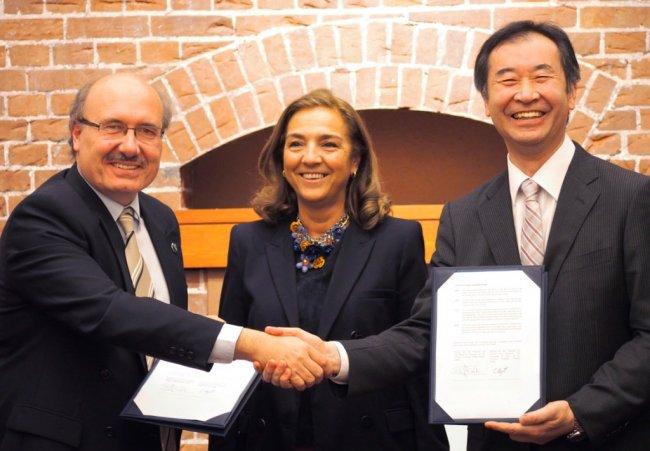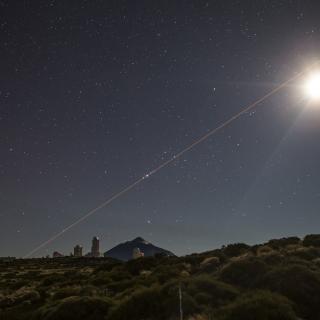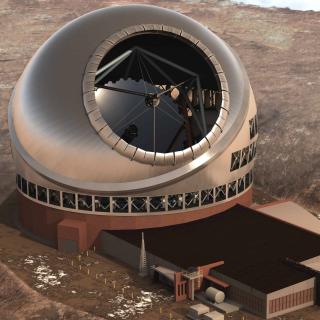The acting Secretary of State for R+D+i, Carmen Vela, presided, together with the Japanese Deputy Minister of Education, Culture, Sport, Science and Technology, Tsutomu Tomioka, over the signing of the collaborative agreement for the installation and operation of four Cherenkov telescopes at the Roque de los Muchachos Observatory on the Island of La Palma. The agreement was signed in Tokyo by Rafael Rebolo, Director of the Instituto de Astrofísica de Canarias (IAC) and Takaaki Kajita, Director of the Institute for Cosmic Ray Research (ICRR) of the University of Tokyo.
The four Cherenkov telescopes, 23 metres in diameter, known as Large Size Telescopes (LST) will permit the observation of high energy gamma rays, and of phenomena associated with dark matter. These telescopes would be the biggest in the CTA-North Observatory, which Spain may host in La Palma, and as a group they would then form the central part of its infrastructure, around which a further 15 telescopes called MST (Medium Size Telescopes), each 12 metres in diameter, would be installed.
The LST telescopes have been designed by researchers and technologists from international universities and research centres (Japan, Iataly, France, Germany, Brazil, India, Sweden and Croatia) in collaboration with Spanish research groups of the University of Barcelona, Instituto de Física de Altas Energías de Barcelona (IFAE), Centro de Investigaciones Energéticas, Medioambientales y Tecnológicas (CIEMAT), Universidad Complutense de Madrid, Universidad Autónoma de Barcelona, Instituto de Ciencias del Espacio of the Universidad Autónoma de Barcelona, Universidad de Jaén and the IAC.
This new international scientific infrastructure will multiply by ten the capabilities of present day instruments, which will allow us to attain a new vision of the Universe, apart from the conventional view from low energy electromagnetic waves, providing un predictable data, presently beyond our reach, on high energy cosmic phenomena such as black holes and supernovae. By the terms of this agreement, the IAC will install and will participate in the development and operation of the four telescopes, guaranteeing the right of the scientific community to use them, and renewing its validity year by year after an initial period of a decade.
CTA
The CTA consortium is made up by over 1,200 scientists working in 200 research centres in 32 countries. Spain and Japan are the two major contributors to CTA-North. The objective of the consortium is to build a telescopic array for the detection of extremely high energy gamma rays which yield information about the most violent extreme events occurring in the universe.
The Ministry of Economy and Competitivity has added its major financial effort to those of other international and national entities to bring the CTA-North to Spain, providing a fund of 40 million euros, which is half the total construction cost.
The CTA is formed by two observatories, one in the northern and the other in the southern hemisphere. The total array will be made up of 120 telescopes, distributed between the two. The CTA-North observatory may be sited at the Roque de los Muchachos Observatory on the Island of La Palma, while CTA-South may be at the Observatory of the European Southern Observatory (ESO), at Cerro Paranal (Chile).
Spanish-Japanese Forum
The acting Secretary of State for Research, Development and Innovation has also paid a visit to the Japanese Agency of Medical Research and Development, and has met with its President, Makoto Suemats, in order to learn about Japanese scientific advances in this field, and to explore bilateral collaboration.
Vela will also attend the XVIII Spanish-Japanese Forum, where attention will be focused on population aging. Spain and Japan are the two countries with the longest life expectancy, and share a population pyramid with a similar structure, so that joint work in this area could be very beneficial for both countries.
More information:
Press release of the Ministry of Economy and Competitivity



